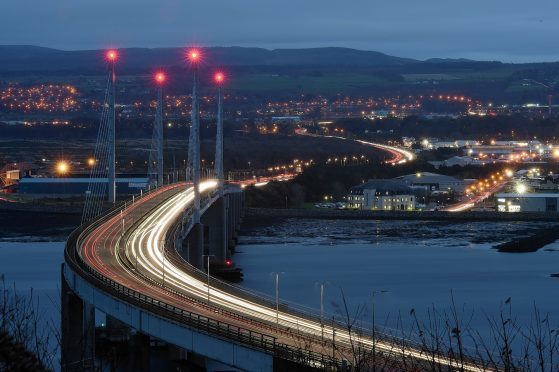Fresh calls have been made for action to ease rush-hour “mayhem” at the Kessock Bridge after new figures revealed that traffic rates have soared by up to two-thirds in little more than 20 years.
Official data shows that the main gateway into the city from the north is being used by more and more commuters and visitors each week.
The average number of vehicles using the bridge during the working week in February and March was more than 50% higher than two decades ago.
And in some months the traffic volumes in the last year are more than 60% higher compared to the figures for 1992/93.
Last night, the statistics prompted renewed calls for a new transport strategy for the Highland capital – including park-and-ride facilities and for a “major redesign” of the Longman Roundabout.
Transport Scotland, which released the data to the Press and Journal, revealed it would publish its plans to tackle congestion in the city in the “coming weeks”.
Officials also said they were reviewing the controversial traffic lights system at the Longman Roundabout.
David Stewart, Labour MSP for the Highlands, said the figures underlined the need for action to tackle gridlock in the area.
“I still feel that the Longman Roundabout isn’t fit for purpose and I think it requires a major redesign to stop the traffic mayhem there at rush-hour,” he said.
The Kessock Bridge opened in 1982 with a design life of 120 years.
Compared to figures from 1994/95, the most recent data for this year shows traffic levels were 33% higher in January, 52% up in February, there was a 50% increase in March, 47% in April, 44% in May, 38% in June and 42% in July.
The 30,372 average vehicle movement figure for November last year represented a 67% rise from the 18,206 statistic for the same month in 1992.
But the data also shows that traffic rates halved in some months compared to the previous year while major resurfacing work was carried out between April 2013 and March 2014.
Transport Scotland and the local authority are developing the so-called east link route between the A9 and A96 on the outskirts of Inverness, and the plans could include a new flyover for the A9 Inverness-Perth road at the Longman Roundabout.
Local authority leaders also hope the improvements can be included in Inverness’s bid for a lucrative City Deal.
Stewart Nicol, chief executive of Inverness Chamber of Commerce, said the figures confirmed the importance of the bridge to the region.
“It’s an excellent problem to have – it just confirms the remarkable difference that the bridge has made to the communities and economy north of Inverness,” he said.
“It has certainly opened up the whole of the Highlands as a commuter option for the city.”
Fraser Grieve, regional director of the Scottish Council for Development and Industry, said: “These figures showing the rising number of vehicles using the Kessock Bridge will not come as a surprise to those who regularly travel this busy section of the A9.
“The Kessock Bridge roundabout has been struggling to cope with traffic volumes for many years and the grade separation of that key interchange must be progressed in order to address congestion and improve the flow of traffic.”
Drew Hendry, SNP transport spokesman and MP for Inverness, Nairn, Badenoch and Strathspey, said: “Cars will be part of Highland life for some time to come so we need to have some vision to deal with the issues for the future and the Kessock bridge is a good example of a pressure point.
“Given the rapid growth of Inverness and the fact that work is underway from the Scottish Government to dual the A9 between Inverness and Perth, with the same in store for the A96, there is now a clear need for a coordinated local transport strategy in and around the city – including the Kessock Bridge.”
A Transport Scotland spokesman said: “The Scottish Government wants to see improvements to our roads infrastructure right across the country to help support Scotland’s economy, including Inverness.
“It is why we are pressing ahead with a major programme of works to dual the A9 and A96, amounting to nearly 170 miles of upgraded road.
“We are also taking forward the A9/A96 Connections Study which is looking at the problems, opportunities and issues concerning traffic travelling between Inshes, Raigmore and Longman junctions in Inverness to develop a potential solution to the congestion and journey time reliability issues that exist at these key junctions.
“The report, which is also reviewing the recently adopted Highland Council land-use and transport proposal, is due to be published in the coming weeks.”
